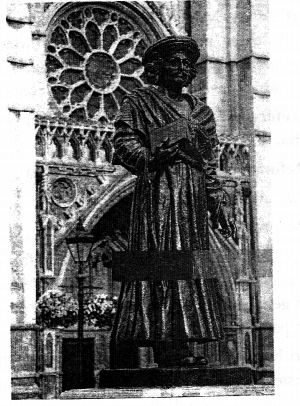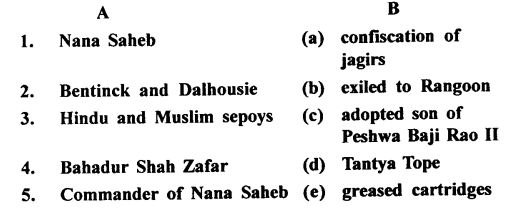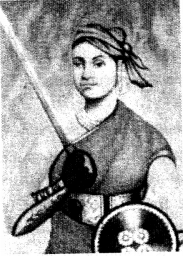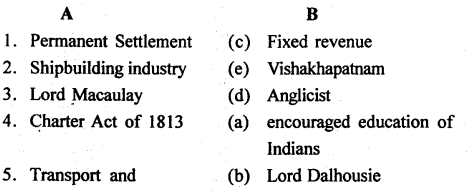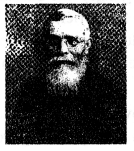The Trail History and Civics for Class 8 ICSE Solutions – The Indian National Movement (1885-1916)
ICSE SolutionsSelina ICSE SolutionsML Aggarwal Solutions
The Trail History and Civics for Class 8 ICSE Answers
Trail HistoryCivics Focus on HistoryCivics GeographyBiologyChemistryPhysicsMaths
Exercises
A. Fill in the blanks:
- The early nationalists spread political awareness among the people.
- The assertive nationalists believed that British rule in India was not a blessing but a curse.
- After the partition of Bengal, the assertive nationalists adopted the methods of boycott, swadeshi and national education to achieve the goal of swaraj.
- Separate electorates meant that the Muslim voters could elect Muslim representatives.
- The early nationalist leaders expelled the assertive nationalists from the Congress at the Surat session in 1907.
B. Match the following:

![]()
Answer:

C. Choose the correct answer:
1. The history of the Indian national movement is broadly categorized into three/four/five
Ans. The history of the Indian national movement is broadly categorized into three phases.
2. Bal Gangadhar Tdak/Dadabhai Naoroji/Surendranath Banerjea was an important assertive nationalist leader.
Ans. Bal Gangadhar Tilak was an important assertive nationalist leader.
3. The British followed the policy of divide and rule by dividing Bengal/Punjab/Gujarat on communal lines.
Ans. The British followed the policy of divide and rule by dividing Bengal on communal lines.
4. The Muslim League was established in 1905/1906/1913.
Ans. The Muslim League was established in 1906.
5. Two Home Rule Leagues were formed in 1916/1914/1918.
Ans. Two Home Rule Leagues were formed in 1916.
D. State whether the following are true or false:
- The early nationalists believed in the justice and fair play of the British.
True. - The early nationalists presented their grievances to the British in the form of protests and strikes.
False.
Correct: The early nationalists presented their grievances to the British in the form of meetings, lectures and the press. - The political beliefs, aims and methods of the assertive nationalists were the same as those of the early nationalists.
False.
Correct: The political beliefs, aims and methods of the assertive nationalists were different as those of the early nationalists. - The assertive nationalists had no faith in the constitutional methods followed by the early nationalists.
True. - Tilak knew that the British would concede to the demand of swaraj easily without any struggle.
False. - Correct: Tilak knew that the British would never concede to the demand of Swaraj easily without any struggle.
E. Answer the following questions in one or two words/ sentences:
Question 1.
Mention two leaders of the early nationalist phase.
Answer:
The important leaders of the early nationalist phase were Dadabhai Naoroji, Surendranath Banerjea and Gopal Krishna Gokhale.
Question 2.
Mention two leaders of the assertive nationalist phase.
Answer:
The important leaders of the assertive nationalist phase were Bal Gangadhar Tilak, Bipin Chandra Pal, Lala Lajpat Rai and Aurobindo Ghosh.
Question 3.
Why were the assertive nationalists disillusioned with the leadership of the early nationalists?
Answer:
The assertive nationalists had no faith in the constitutional methods followed by the early nationalists. They knew that the British would never concede to the demand for swaraj without a struggle. So they have to adopt a method of active opposition to government Swaraj would have to be achieved through a political, anti-government agitation and with the involvement and support of the masses. The Congress would have to be transformed from a platform for debates among the westernized, Indian intelligentsia into a regiment of freedom fighters-united, determined, confident and willing to make sacrifices.
Question 4.
When and why was Bengal partitioned?
Answer:
The British partitioned Bengal in 1905 in pursuance of their policy of divide and rule.
Question 5.
Where and under whose leadership was the Muslim League established?
Answer:
The Muslim League was established in December 1906, under the leadership of Nawab Salimullah Khan in Dacca (now known as Dhaka).
Question 6.
Mention two objectives of the Muslim League?
Answer:
Objectives of Muslim league:
- To promote among the Muslims a feeling of loyalty towards the British government.
- To protect and promote the political rights of the Muslims.
- To prevent feelings of hostility towards other communities.
Question 7.
Why was the introduction of separate electorates a death blow to national unity?
Answer:
Separate electorates refers to the voting population of the country, divided into different electorates based on the factors like religion, caste, occupation etc. For example, it meant that Muslim voters could elect Muslim representatives. The introduction of separate electorates sounded the death knell of national unity. It was the first definite step on the road to the partition of India.
Question 8.
Why did the Indian nationalists support the war effort of the British when the First World War broke out ?
Answer:
Initially, there was an outburst of loyalty and the Indian nationalist leaders supported the British government with men and money. More than a million Indian soldiers were sent overseas to join the British army and a hundred million pounds were given to the British government.
The British and their allies declared that they were fighting the war to make the world ‘safe for democracy’ and to promote the right of all nations to form self-governments. This led the Indian nationalists to believe that a grateful Britain would reward India’s loyalty and fulfill its demands for self-government.
Question 9.
What was the main aim of the Home Rule Leagues ?
Answer:
The main aim of the Leagues was to achieve self-government within the British empire after the war.
F. Answer the following questions briefly:
Question 1.
With reference to the early nationalists, discuss the following:
(a) Beliefs of the early nationalists
(b) Methods of the early nationalists
(c) Important contributions made by the early nationalists to the national movement?
Answer:
(a)
The early nationalists believed that British rule had conferred several benefits on India. They felt that at that stage of history it was in their own interests to remain under the British since they were not yet ready to govern themselves. The early nationalists were convinced that the British could be persuaded to introduce necessary reforms and the government could be transformed to suit the interests of the Indian subjects.
(b)
The early nationalists had great faith in the sense of justice and fair play of the British.. So they adopted peaceful and constitutional methods. They presented their grievances to the government and waited patiently for the government to pass laws to remove those grievances. They believed that the government would gradually give into their demands. They promoted unity, spread political awareness among the people and built up a strong public opinion through meetings, lectures and the press. They also sent delegations to England to persuade the British government to introduce necessary reforms.
(c)
Contribution of the early nationalists:
- The early nationalists established a solid foundation which served as a base for a more radical approach in later years.
- They spread political awareness among the people and instilled in them a sense of national unity. The people began to think of themselves as a members of one single nation the Indian nation. The path for a united national struggle was laid.
- The Congress under the early nationalists trained the Indians in political affairs. They educated them in political matters and familiarized them with ideas of – freedom, government, democracy, secularism nationalism, etc. This knowledge and training in political affairs helped Indian nationalists to organize and raise the national movement to the next stage of development.
Question 2.
With reference to the rise of the assertive nationalists within the congress, discuss:
(a) The beliefs of the assertive nationalists
(b) The objectives of the assertive nationalists
(c) How the methods of the assertive nationalists differed from those of the early nationalists?
Answer:
(a)
The assertive nationalists had no faith in the British sense of justice and fair play. They believed that the British rule in India was not a blessing but a curse. They were convinced that the British had no honest intentions of introducing reforms for the welfare of the Indians. They realized that the British interests were different and clashed with the Indian interests. India could never grow and progress under British rule.
(b)
The goal of the assertive nationalists was not self government in ‘gradual’ stages but immediate freedom (Swaraj) from British rule.
(c)
The early nationalists had great faith in the sense of justice and fair play of the British. So they adopted peaceful and constitutional methods. They presented their grievances to the government and waited patiently for the government to pass laws to remove those grievances. They believed that the government would gradually give in to their demands. They promoted unity, spread political awareness among the people and built up a strong public opinion through meetings, lectures and the press. But the assertive nationalists on the other hand, had no faith in the constitutional methods followed by the early nationalists. Twenty years of prayers, petitions, appeals and resolutions and representations hadfailed to yield any concrete results,
Question 3.
With reference to the Lucknow Session of the Congress of 1916, answer the following questions:
Question 3(a).
What was the Lucknow Pact ?
Answer:
The Lucknow Pact was an agreement signed by the Muslim League and the Congress to pave the way for a joint scheme of political reforms in India.
Question 3(b).
What was the objective of the Lucknow Pact ?
Answer:
Under the Lucknow Pact, the League jointly with the Congress put forward the demand for a Dominion Status for India. This was an important step towards Hindu-Muslim unity.
Question 3(c).
What were the results of Lucknow Pact ?
Answer:
The unity between the Muslim League and the Congress, on the one hand and the early nationalists and the assertive nationalists, on the other, aroused great political enthusiasm and strengthened the national movement.
G Picture study:
This is the picture of a national leader
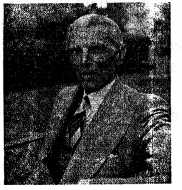
1.Identify the person in the picture.
Ans. Muhammad Ali Jinnah.
2. Which political organization did he join and when ?
Ans. Muhammad Ali Jinnah joined the Muslim League in 1913.
3. When and by whom was this organization founded ?
Ans. The Muslim League was established in December 1906, under the leadership of Nawab Salimullah Khan in Dacca (now known as Dhaka).
4. What were the objectives of this organization ?
Answer:
The main objectives of the Muslim League were as follows:
- To promote among the Muslims a feeling of loyalty towards the British government.
- To protect and promote the political rights of the Muslims
- To prevent feelings of hostility towards other communities.





